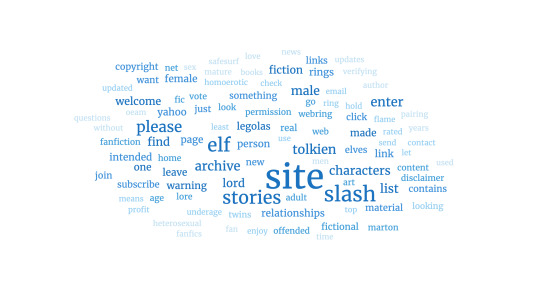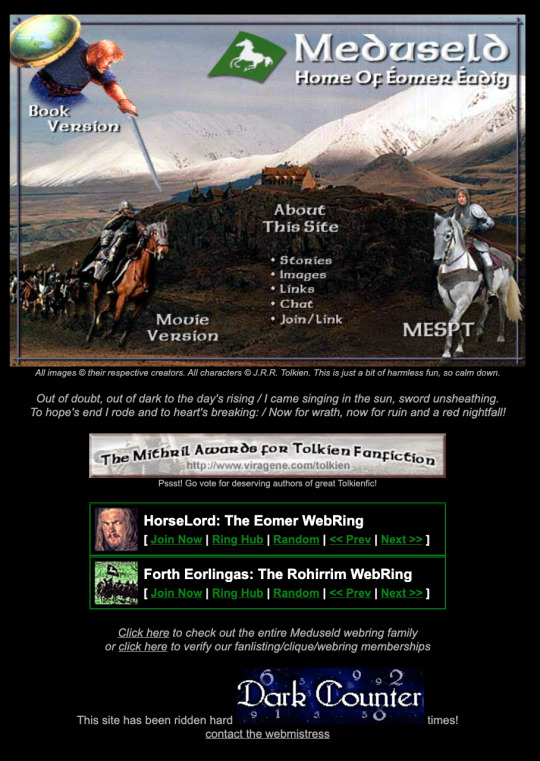#issue:slash
Explore tagged Tumblr posts
Text
Robin is a Tolkien and fan studies scholar, an academic, a fic writer ... and now retired. Which means she is finally able to write and share the fan studies work she's been doing for decades but couldn't publish because she was caught up in publishing for academia. (The great irony!)
Robin has a newsletter, and "Queer Intersections" is this week's edition, looking at 2008 survey data she collected but never published on genre preferences among readers (mostly women) of Tolkien darkfic. Robin's data looks at the genre preferences of a group of readers who enjoy two specific LotR-based darkfics, in terms of both Fictional Person Fiction/Slash (FPF/S) and Real Person Fiction/Slash (RPF/S). Her data finds, not surprisingly, that women who enjoy darkfic don't conform to what the literature suggests are genre preferences for women more generally. More surprisingly, there were distinct differences in their preferences based on whether the story was FPF/S or RPF/S.
The article also includes some essential history of slash and how slash has been discussed in fan studies scholarship. And of course the survey itself is more than ten years old now, so it is a snapshot of Tolkien fandom history.
And did I mention that this is part of Robin's newsletter?? In addition to her work on queer fanfiction, she also does fascinating work on the co-opting and use of Tolkien as a recruiting tool by fascist and alt-right movements ... fascinating, chilling, and very important work.
2 notes
·
View notes
Text
2000s Tolkien Fanfiction Splash Pages

If you read Tolkien fanfiction in the 2000s, you probably passed a splash page or two in your quest for fic. These pages, located at the site's index page or homepage, served as a buffer between the visitor and the site's content. You often had to click to "enter" the site. They contained warnings; disclaimers; spiffy images and backgrounds; affiliate links, awards, webrings, and Yahoo! Groups; and (my favorite) invitations to LEAVE NOW if "offended" by the content on the site. (The LEAVE NOW link usually pointed to Google.com, though Least Expected helpfully invites wayward prudes to "Head on over to theonering.net or something.)
I grabbed the text from about a dozen splash pages from the early-mid 2000s (the oldest, King & Herald, was from 2007; all others are 2001-4) and made the word cloud above, which illustrates the climate and concerns of fanfiction archivists in the first years Tolkien-based fanfiction was online.
I'll share a few of my favorite splash pages below the jump.
Fanfiction was scary. Slashfic was scarier.

Many splash pages assumed that the people visiting the site were going to be offended by the content of the site, especially if that content was slash fanfiction. I already mentioned the LEAVE NOW links above. Also typical was the understanding that explicit fanfiction (especially slash) was for people over the age of 18. The splash page for Least Expected, circa 2001 and the earliest Tolkienslash archive on the internet, shows how splash pages foregrounded deterrence, even in a group that was unapologetic about its interests, reflecting the larger cultural panic about growing acceptance of sexuality, especially LGBTQIA+.
Sites spelled out very clearly what could be found there: adult-rated material, same-sex pairings, and real person fic (RPF), for example. The site Legolas in Chains even had illustrations. (Content warning for incest and non-con and graphic acts performed by stick figures; see the Legolas in Chains splash page here.) "I will not hold responsibility ..." writes the Legolas in Chains' archivist before launching into the text version of the warning, "just in case you don't get the picture above." This was an important cultural difference between fanfiction fandom in the 2000s and now: Archivists and group owners assumed it was at least partly their responsibility to shield "web surfers" (especially children) from the content on their sites and groups and made an effort to demonstrate that they were fulfilling this obligation.
Slash and adult-rated content weren't the only anxieties on archivists' minds. The words disclaimer, copyright, and permission occurred frequently too. And even larger than those words: please. While many of these splash pages are very direct and some use humor, they tend to be polite. The overwhelming sense from many of this is, "We're not harming you. Please just leave us alone."
2000s Tech.

Splash pages also showcase the rapidly evolving technology of the web. You wanted your splash page to show that you knew what you were doing. The splash page for Meduseld above is a beautiful example.
Splash pages often included banners and graphics, visitor counters, and of course, links to the guestbook. Images sometimes moved and twinkled. Colored text and patterned backgrounds showed the designer's HTML and CSS skills.
Splash pages also reflected the challenges of creating webpages (especially if you were trying to be cutting-edge) in an era where web standards were not universally adopted and sites displayed differently depending on the browser, OS, and resolution of your screen. Splash pages sometimes advised which resolution worked best with the site (some offered a choice!) and which browser the site had been designed in.
Affiliates: A Little Help from My Friends.

The splash pages for Middle Earth Romance Fan-Fiction and Meduseld both highlight the importance of a splash page in announcing your affiliates. The majority of these archives developed out of a community, usually on Yahoo! Groups, and linking to the group was essential. As Middle Earth Romance Fan-Fiction shows, sites also had "sister sites" sometimes: sites created by the same designer (but with different focuses) or that otherwise shared resources and collaboration.
The fanfiction community (okay, the internet in general) was also much more fragmented than it is today. Consider that, in the 2000s, there were dozens (probably hundreds, if not more) Tolkien fanfiction archives online. Many of these sites were small and highly specialized. Furthermore, search engine technology was rudimentary, so it wasn't like today when you visit a handful of sites (say, AO3 and Tumblr), type in a tag or search term, and there is your fannish experience, all in one place. You had to work to find groups and archives about what interested you--a challenge compounded by the fact that many of these groups and archives legit feared being sued by New Line or the Tolkien Estate and didn't want to be found.
Webrings, cliques, fanlistings, and awards were one way that small sites got the word out to friendly company. Once you found one site, you could meander through the webring to find others like it. You could join email lists (like Yahoo! Groups) to unlock even more access, since these groups were most often members-only. Most sites had both "Links" and "Link to Us" pages, and exchanging links with another site was common.
You can see my splash page collection here, using the earliest Wayback Machine capture I could find.
(Posted by @dawnfelagund)
#fanwork:fanfiction#fanwork:archives#time:2000s#issue:slash#site:least expected#site:legolas in chains#site:meduseld#site:middle earth romance fan-fiction
5 notes
·
View notes